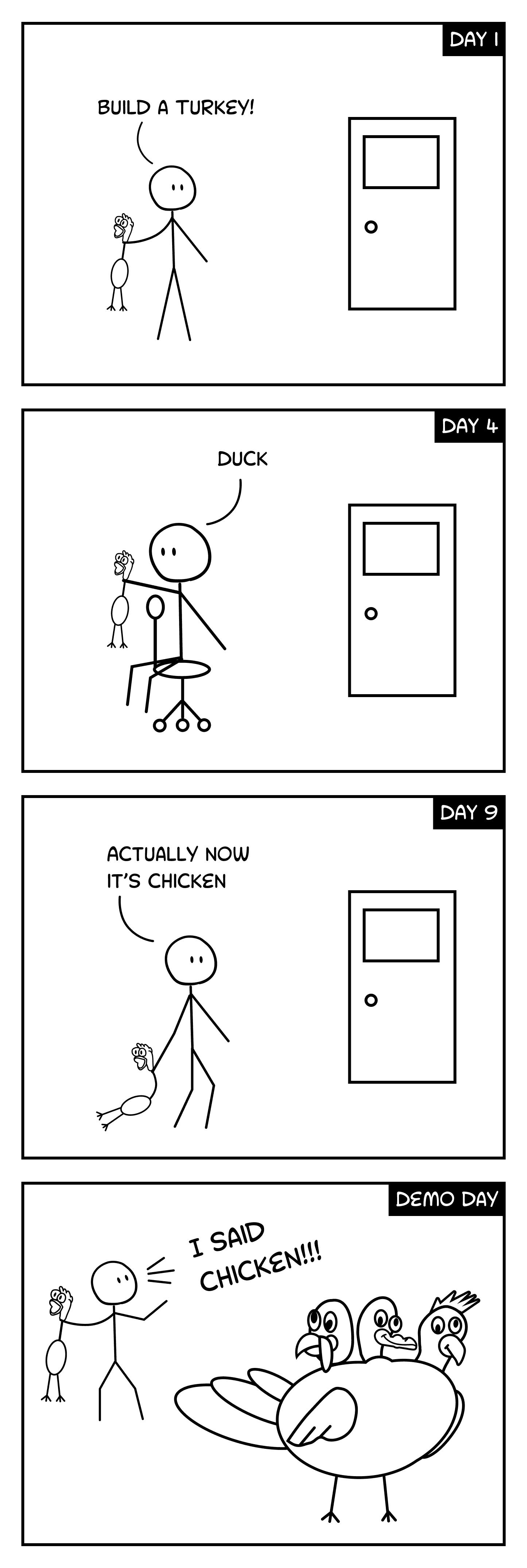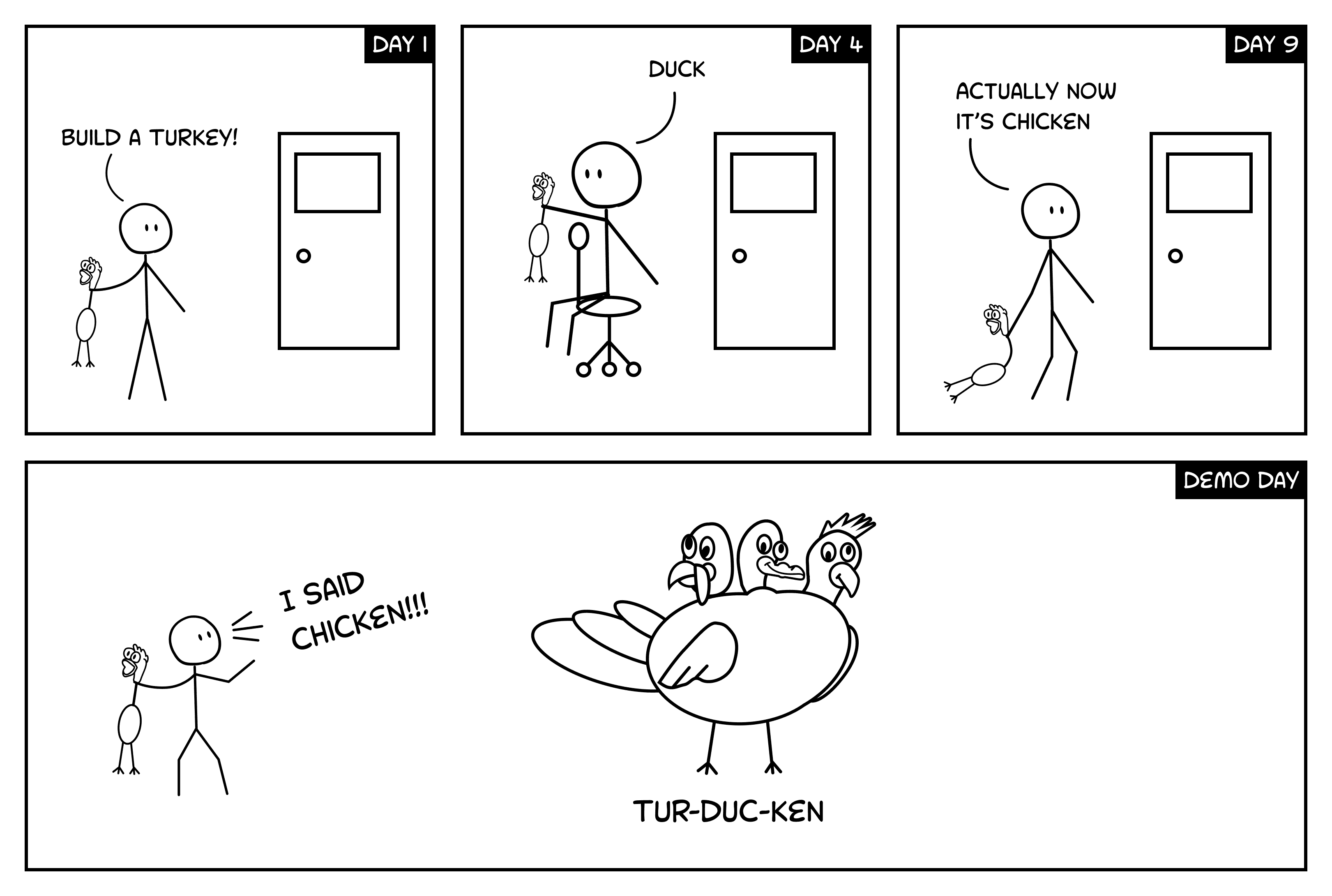
Geo
November 19, 2024
The One With The Turducken Product
Turkey, Duck, Chicken? Yes.
The Agile Turducken
The origin of the turducken is as layered and mysterious as the dish itself, steeped in culinary lore. But like many quirky phenomena, its rise to fame owes a lot to ’90s American marketing—and football. During a 1996 Rams-Saints game in the Superdome, legendary sportscaster John Madden stumbled upon the turducken and couldn’t contain his excitement. Watching him marvel at the concept of stuffing a chicken into a duck into a turkey live on national television was peak ’90s entertainment. It wasn’t just a new dish; it was a moment where Madden’s joy made America collectively think, “I need to try this.”
The same marketing magic that worked for turducken won’t save your Agile planning process. Not even John Madden could salvage the bad PR that comes with constantly shifting requirements.
In Agile, we value responding to change over following a plan, but without proper management, those changes can spiral out of control. What starts as a turkey can quickly become a duck, then a chicken, and by demo day, you’ve got a full-blown turducken of a product—bloated, mismatched, and far from the original vision. The key is to stay agile without letting the process turn into a chaotic nesting doll of last-minute pivots.
First, let’s acknowledge the inevitable: requirements will change. Client needs evolve, new insights surface, and shifting market conditions apply pressure. Flexibility is one of Agile’s greatest strengths, but how a team handles that flexibility can make or break the planning process. Too often, “agility” gets misinterpreted as a license for zero planning, leading to unmanaged changes, confusion, and misalignment.
Enter the turducken effect. This happens when a project’s requirements are constantly tweaked without a cohesive vision. The result? A product Frankenstein. Staying truly Agile means balancing adaptability with disciplined planning to avoid serving up a chaotic dish on demo day.
Every sprint is a chance to pause, recalibrate, and chart the shortest path to delivering value—focusing on collaboration with the customer over rigid adherence to a plan. However, in the world of product development, the “customer” can often feel like a shapeshifting entity: other development teams, the marketing team, paying clients, a product manager, etc. Identifying who truly holds influence over the customer’s voice is critical for managing both product design and expectations effectively.
Before diving into the next sprint, take a moment for quiet reflection. Ask yourself:
What areas will most drive the project’s success?
What functional progress can we realistically expect to make?
How can we ensure stakeholder communication is proactive, not reactive?
Effective communication is key to managing stakeholder expectations. The right cadence prevents last-minute surprises while keeping everyone aligned. But beyond communication, managing scope changes is an underappreciated art in Agile. Instead of fighting against change, create a strong, transparent process for handling scope shifts. Track the interruptions, record their impact on the sprint, and document the narrative for future reflection. This not only keeps the team on track but provides valuable insights when revisiting why certain decisions were made.
Finally, clarity is everything. Every sprint increment should have a defined finish line: tasks fully complete, no loose ends, and a clear trajectory for what comes next. With discipline and focus, sprints become more than cycles of work—they’re deliberate steps toward delivering real value.
Prioritizing Some Changes Over Others
Change requests are inevitable in any Agile project. Managing them effectively requires thoughtful prioritization, and the first step is to evaluate each request against the project’s goals. Does the requested change enhance or detract from the goal? This is the duty of Agile practitioners: to ensure that changes align with the overarching vision and deliver value without derailing the project.
Frame Change Requests in Terms of Goals
When a change is proposed, anchor the discussion in the project’s objectives. Clearly articulate how (or if) the change contributes to the desired outcomes. Support your case with relevant data—user feedback, analytics, or project metrics—so the conversation stays grounded in facts, not opinions. This evidence-based approach helps stakeholders weigh the true benefits of altering the scope.
Communicate the Trade-offs
Transparency is critical when discussing how a change could impact the timeline, budget, or resources. Spell out the trade-offs clearly: “If we include this feature now, it could delay the release by two weeks” or “Adding this feature may mean removing another from this sprint.” When stakeholders understand the consequences, they can make better-informed decisions about what’s truly essential.
Involve Stakeholders in the Prioritization Process
For more collaborative projects, involve stakeholders directly in the prioritization process. Share your method for prioritization and rationale. This not only builds buy-in but also ensures the product captures the collective wisdom of the team and meets a broader range of requirements.
Gathering the Universe of Ideas
In some product development efforts, the goal is to collect and refine a universe of requirements. Stakeholders bring unique perspectives, and their input can illuminate opportunities the team might overlook. Structuring these contributions into a coherent prioritization process ensures that the product evolves thoughtfully, capturing the best ideas while staying focused on the end goal.
By framing changes around goals, communicating trade-offs, and fostering stakeholder collaboration, you can ensure that only the most valuable changes are implemented, keeping the project aligned and agile.
Defer Non-Essential Changes, Diplomatically
Not all change requests fit within the current sprint goals or constraints. A well-timed “Not Yet” can keep stakeholders engaged while maintaining focus on priorities.
Document and Track Requests: Log all requests in the backlog to show stakeholders their input is valued and will be revisited.
Set Clear Expectations: Define a target for when and how the request will be re-evaluated, e.g., after gathering user feedback or completing higher-priority tasks.
By respectfully deferring non-essential changes, teams can protect project quality, maintain stakeholder trust, and prioritize long-term value without losing sight of the bigger picture.



